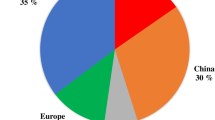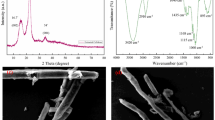Abstract
In this work, we synthesized p-phenylenediamine modified carbon nanotubes (P-CNTs) by diazotization reaction. The resulting material shows a BET surface area of 285 m2 g−1 and a total volume of 0.65 cm3 g−1 with abundant mesopores. Also, the P-CNTs exhibit good surface hydrophobicity with water contact angle of 140.8°, which should be attributed to the cooperation of both surface roughness and hydrophobic chemical compositions (aromatic rings linkages) of P-CNTs. Taking advantages of the intrinsic porosity and surface hydrophobicity, the resulting P-CNTs exhibit a notably selective absorbing ability and good recyclability for removal of organics and oils from water, which makes them the promising candidates for liquid–liquid separation and waste oil treatment.







Similar content being viewed by others
References
Hayase G, Kanamori K, Fukuchi M, Kaji H, Nakanishi K (2013) Facile synthesis of marshmallow-like macroporous gels usable under harsh conditions for the separation of oil and water. Angew Chem Int Ed 52:1986–1989
Yip TL, Talley WK, Jin D (2011) The effectiveness of double hulls in reducing vessel-accident oil spillage. Mar Pollut Bull 62:2427–2432
Li H, Boufadel MC (2010) Long-term persistence of oil from the Exxon Valdez spill in two-layer beaches. Nat Geosci 3:96–99
Xue Z, Wang S, Lin L, Chen L, Liu M, Feng L, Jiang L (2011) A novel superhydrophilic and underwater superoleophobic hydrogel-coated mesh for oil/water separation. Adv Mater 23:4270–4273
Kota AK, Kwon G, Choi W, Mabry JM, Tuteja A (2012) Hygro-responsive membranes for effective oil-water separation. Nat commun 3:1025–1032
Coasne B, Alba-Simionesco C, Audonnet F, Dossehc G, Gubbins KE (2011) Adsorption, structure and dynamics of benzene in ordered and disordered porous carbons. Phys Chem Chem Phys 13:3748–3757
Zhao H, Nagy KL (2004) Dodecyl sulfate–hydrotalcite nanocomposites for trapping chlorinated organic pollutants in water. J Colloid Interface Sci 274:613–624
Yang J, Lee S, Lee H, Lee J, Kim HK, Lee SU, Sohn D (2011) Synthesis of an attapulgite clay@carbon nanocomposite adsorbent by a hydrothermal carbonization process and their application in the removal of toxic metal ions from water. Langmuir 27:8998–9004
Kalies G, Rockmann R, Tuma D, Gapke J (2010) Ordered mesoporous solids as model substances for liquid adsorption. Appl Surf Sci 256:5395–5398
Tan D, Xiong W, Sun H, Zhang Z, Ma W, Meng C, Fan W, Li A (2013) Conjugated microporous polymer with film and nanotube-like morphologies. Micropor Mesopor Mater 176:25–30
Tan D, Fan W, Xiong W, Sun H, Cheng Y, Liu, Meng C, Li A, Deng WQ (2012) Study on the morphologies of covalent organic microporous polymers: the role of reaction solvents. Macromol Chem Phys 213:1435–1440
Tan D, Fan W, Xiong W, Sun H, Li A, Deng W, Meng C (2012) Study on adsorption performance of conjugated microporous polymers for hydrogen and organic solvents: the role of pore volume. Eur Polym J 48:705–711
Yuan J, Liu X, Akbulut O, Hu J, Suib SL (2008) Superwetting nanowire membranes for selective absorption. Nat Nanotechnol 3:332–336
Bi H, Xie X, Yin K, Zhou Y, Wan S, He L, Xu F, Banhart F, Sun L, Ruoff RS (2012) Spongy graphene as a highly efficient and recyclable sorbent for oils and organic solvents. Adv Funct Mater 22:4421–4425
Nguyen DD, Tai NH, Lee SB, Kuo WS (2012) Superhydrophobic and superoleophilic properties of graphene-based sponges fabricated using a facile dip coating method. Energy Environ Sci 5:7908–7912
Zhang Y, Wei S, Liu F, Du Y, Liu S, Ji Y, Yokoi T, Tatsumi T, Xiao FS (2009) Superhydrophobic nanoporous polymers as efficient adsorbents for organic compounds. Nano Today 4:135–142
Li A, Sun HX, Tan DZ, Fan WJ, Wen SH, Qing XJ, Li GX, Li SY, Deng WQ (2011) Superhydrophobic conjugated microporous polymers for separation and adsorption. Energy Environ Sci 4:2062–2065
Sun H, Li A, Zhu Z, Liang W, Zhao X, La P, Deng W (2013) Superhydrophobic activated carbon-coated sponges for separation and absorption. ChemSusChem 6:1057–1062
Jin Y, Hawkins SC, Huynh CP, Su S (2013) Carbon nanotube modified carbon composite monoliths as superior adsorbents for carbon dioxide capture. Energy Environ Sci 6:2591–2596
Gui X, Wei J, Wang K, Cao A, Zhu H, Jia Y, Shu Q, Wu D (2010) Carbon nanotube sponges. Adv Mater 22:617–621
Shannon MA, Bohn PW, Elimelech M, Georgiadis JG, Marinas BJ, Mayes AM (2008) Science and technology for water purification in the coming decades. Nature 452:301–310
Peng X, Li Y, Luan Z, Di Z, Wang H, Tian B, Jia Z (2003) Adsorption of 1,2-dichlorobenzene from water to carbon nanotubes. Chem Phys Lett 376:154–158
Li YH, Wang S, Luan Z, Ding J, Xu C, Wu D (2003) Adsorption of cadmium(II) from aqueous solution by surface oxidized carbon nanotubes. Carbon 41:1057–1062
Mauter MS, Elimelech M (2008) Environmental applications of carbon-based nanomaterials. Environ Sci Technol 42:5843–5859
Pan B, Xing B (2008) Adsorption mechanisms of organic chemicals on carbon nanotubes. Environ Sci Technol 42:9005–9013
Leonard AD, Hudson JL, Fan H, Booker R, Simpson LJ, ONeill KJ, Parilla PA, Heben MJ, Pasquali M, Kittrell C, Tour JM (2009) Nanoengineered carbon scaffolds for hydrogen storage. J Am Chem Soc 131:723–728
Hu H, Zhao B, Hamon MA, Kamaras K, Itkis ME, Haddon RC (2003) Sidewall functionalization of single-Walled carbon nanotubes by addition of dichlorocarbene. J Am Chem Soc 125:14893–14900
Li H, Cheng F, Duft AM, Adronov A (2005) Functionalization of single-walled carbon nanotubes with well-defined polystyrene by “click” coupling. J Am Chem Soc 127:14518–14524
Maphutha S, Moothi K, Meyyappan M, Iyuke SE (2013) A carbon nanotube-infused polysulfone membrane with polyvinyl alcohol layer for treating oil-containing waste water. Sci Rep 3:1509–1514
Liao Q, Sun J, Gao L (2008) The adsorption of resorcinol from water using multi-walled carbon nanotubes. Colloid Surf A 312:160–165
Buttry DA, Peng JCM, Donnet J, Rebouillat S (1999) Immobilization of amines at carbon fiber surfaces. Carbon 37:1929–1940
Donnet J, Wang TK, Peng JCM, Rebouillat S (1998) Carbon fibers. Marcel Deckert, New York
Pei C, Sun H, Zhu Z, Liang W, Jin An, Zhang Q, Li A (2014) Synthesis of novel porous graphene nanocomposite and its use as electrode and absorbent. RSC Adv 4:14042–14047
Wang K, Hu NX, Xu G, Qi Y (2011) Stable superhydrophobic composite coatings made from an aqueous dispersion of carbon nanotubes and a fluoropolymer. Carbon 49:1769–1774
Zhu X, Zhang Z, Ren G, Yang J, Wang K, Xu X, Men X, Zhou X (2012) A novel superhydrophobic bulk material. J Mater Chem 22:20146–20148
Dyke CA, Tour JM (2003) Solvent-free functionalization of carbon nanotubes. J Am Chem Soc 125:1156–1157
Bahr JL, Tour JM (2001) Highly functionalized carbon nanotubes using in situ generated diazonium compounds. Chem Mater 13:3823–3824
Mamedov AA, Kotov NA, Prato M, Guldi DM, Wicksten JP, Hirsch A (2002) Molecular design of strong single-wall carbon nanotube/polyelectrolyte multilayer composites. Nat Mater 1:190–194
Yang Z, Xia Y, Mokaya R (2007) Enhanced hydrogen storage capacity of high surface area zeolite-like carbon materials. J Am Chem Soc 129:1673–1679
Ci L, Wei B, Xu C, Liang J, Wu D, Xie S, Zhou W, Li Y, Liu Z, Tang D (2001) Crystallization behavior of the amorphous carbon nanotubes. J Cryst Growth 233:823–828
Li W, Liang C, Zhou W, Qiu J, Zhou Z, Sun G, Xin Q (2003) Preparation and characterization of multiwalled carbon nanotube-supported platinum for cathode catalysts of direct methanol fuel cells. J Phys Chem B 107:6292–6299
McNally T, Potschke P, Halley P, Murphy M, Martin D, Belld SEJ, Brennane GP, Beinf D, Lemoineg P, Quinng JP (2005) Polyethylene multiwalled carbon nanotube composites. Polymer 46:8222–8232
Feng W, Bai XD, Lian YQ, Liang J, Wang XG, Yoshino K (2003) Well-aligned polyaniline/carbon-nanotube composite films grown by in situ aniline polymerization. Carbon 41:1551–1557
Pirlot C, Willems I, Fonseca A, Nagy JB, Delhalle J (2002) Preparation and characterization of carbon nanotube/polyacrylonitrile composites. Adv Eng Mater 4:109–114
Chen J, Rao AM, Lyuksyutov S, Itkis ME, Hamon MA, Hu H, Cohn RW, Eklund PC, Colbert DT, Smalley RE, Haddon RC (2001) Dissolution of full-length single-walled carbon nanotubes. J Phys Chem B 105:2525–2528
Li H, Wang X, Song Y, Liu Y, Li Q, Jiang L, Zhu D (2001) Super-“amphiphobic” aligned carbon nanotube films. Angew Chem Int Ed 40:1743–1746
Wang CF, Tzeng FS, Chen HG, Chang CJ (2012) Ultraviolet-durable superhydrophobic zinc oxide-coated mesh films for surface and underwater–oil capture and transportation. Langmuir 28:10015–10019
Fan ZL, Qin XJ, Sun HX, Zhu ZQ, Cj Pei, Liang WD, Bao XM, An J, La PQ, Li A, Deng WQ (2013) Superhydrophobic mesoporous graphene for separation and absorption. ChemPlusChem 78:1282–1287
Acknowledgements
The authors are grateful to the National Natural Science Foundation of China (Grant Nos. 51263012, 51262019 and 21306072), Fundamental Research Funds for the Universities of Gansu Province and Gansu Provincial Science Fund for Distinguished Young Scholars (Grant No. 1308RJDA012).
Author information
Authors and Affiliations
Corresponding author
Rights and permissions
About this article
Cite this article
Sun, H., La, P., Zhu, Z. et al. Hydrophobic carbon nanotubes for removal of oils and organics from water. J Mater Sci 49, 6855–6861 (2014). https://doi.org/10.1007/s10853-014-8387-9
Received:
Accepted:
Published:
Issue Date:
DOI: https://doi.org/10.1007/s10853-014-8387-9




